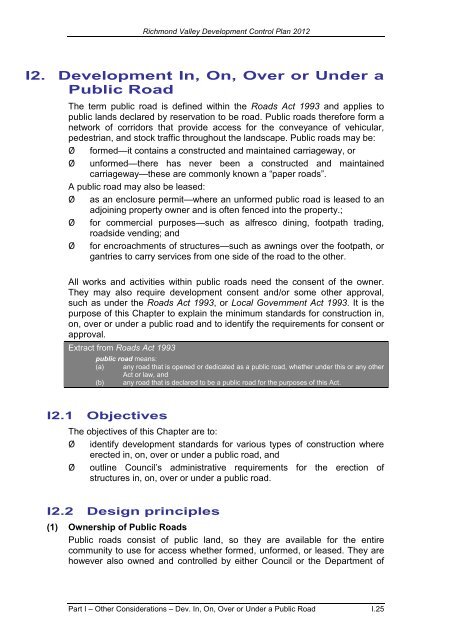Part I - Other Considerations - Richmond Valley Council
Part I - Other Considerations - Richmond Valley Council Part I - Other Considerations - Richmond Valley Council
Richmond Valley Development Control Plan 2012I2. Development In, On, Over or Under aPublic RoadThe term public road is defined within the Roads Act 1993 and applies topublic lands declared by reservation to be road. Public roads therefore form anetwork of corridors that provide access for the conveyance of vehicular,pedestrian, and stock traffic throughout the landscape. Public roads may be:‣ formed—it contains a constructed and maintained carriageway, or‣ unformed—there has never been a constructed and maintainedcarriageway—these are commonly known a “paper roads”.A public road may also be leased:‣ as an enclosure permit—where an unformed public road is leased to anadjoining property owner and is often fenced into the property.;‣ for commercial purposes—such as alfresco dining, footpath trading,roadside vending; and‣ for encroachments of structures—such as awnings over the footpath, organtries to carry services from one side of the road to the other.All works and activities within public roads need the consent of the owner.They may also require development consent and/or some other approval,such as under the Roads Act 1993, or Local Government Act 1993. It is thepurpose of this Chapter to explain the minimum standards for construction in,on, over or under a public road and to identify the requirements for consent orapproval.Extract from Roads Act 1993public road means:(a) any road that is opened or dedicated as a public road, whether under this or any otherAct or law, and(b) any road that is declared to be a public road for the purposes of this Act.I2.1 ObjectivesThe objectives of this Chapter are to:‣ identify development standards for various types of construction whereerected in, on, over or under a public road, and‣ outline Council’s administrative requirements for the erection ofstructures in, on, over or under a public road.I2.2 Design principles(1) Ownership of Public RoadsPublic roads consist of public land, so they are available for the entirecommunity to use for access whether formed, unformed, or leased. They arehowever also owned and controlled by either Council or the Department ofPart I – Other Considerations – Dev. In, On, Over or Under a Public Road I.25
- Page 3 and 4: Richmond Valley Development Control
- Page 5 and 6: Richmond Valley Development Control
- Page 7 and 8: Richmond Valley Development Control
- Page 9 and 10: Richmond Valley Development Control
- Page 11 and 12: Richmond Valley Development Control
- Page 13 and 14: Richmond Valley Development Control
- Page 15 and 16: Richmond Valley Development Control
- Page 17 and 18: Richmond Valley Development Control
- Page 19 and 20: Richmond Valley Development Control
- Page 21 and 22: Richmond Valley Development Control
- Page 23: Richmond Valley Development Control
- Page 27 and 28: Richmond Valley Development Control
- Page 29 and 30: Richmond Valley Development Control
- Page 31 and 32: Richmond Valley Development Control
- Page 34 and 35: Richmond Valley Development Control
- Page 37 and 38: Richmond Valley Development Control
- Page 39 and 40: Richmond Valley Development Control
- Page 41 and 42: Richmond Valley Development Control
- Page 43 and 44: Richmond Valley Development Control
- Page 45 and 46: Richmond Valley Development Control
- Page 47 and 48: Richmond Valley Development Control
- Page 49 and 50: Richmond Valley Development Control
- Page 51 and 52: Richmond Valley Development Control
- Page 53 and 54: Richmond Valley Development Control
- Page 55 and 56: Richmond Valley Development Control
- Page 57 and 58: Richmond Valley Development Control
- Page 59: Richmond Valley Development Control
- Page 62 and 63: Richmond Valley Development Control
- Page 64 and 65: Richmond Valley Development Control
- Page 66 and 67: Richmond Valley Development Control
- Page 69 and 70: Richmond Valley Development Control
- Page 71 and 72: Richmond Valley Development Control
- Page 73 and 74: Richmond Valley Development Control
<strong>Richmond</strong> <strong>Valley</strong> Development Control Plan 2012I2. Development In, On, Over or Under aPublic RoadThe term public road is defined within the Roads Act 1993 and applies topublic lands declared by reservation to be road. Public roads therefore form anetwork of corridors that provide access for the conveyance of vehicular,pedestrian, and stock traffic throughout the landscape. Public roads may be:‣ formed—it contains a constructed and maintained carriageway, or‣ unformed—there has never been a constructed and maintainedcarriageway—these are commonly known a “paper roads”.A public road may also be leased:‣ as an enclosure permit—where an unformed public road is leased to anadjoining property owner and is often fenced into the property.;‣ for commercial purposes—such as alfresco dining, footpath trading,roadside vending; and‣ for encroachments of structures—such as awnings over the footpath, organtries to carry services from one side of the road to the other.All works and activities within public roads need the consent of the owner.They may also require development consent and/or some other approval,such as under the Roads Act 1993, or Local Government Act 1993. It is thepurpose of this Chapter to explain the minimum standards for construction in,on, over or under a public road and to identify the requirements for consent orapproval.Extract from Roads Act 1993public road means:(a) any road that is opened or dedicated as a public road, whether under this or any otherAct or law, and(b) any road that is declared to be a public road for the purposes of this Act.I2.1 ObjectivesThe objectives of this Chapter are to:‣ identify development standards for various types of construction whereerected in, on, over or under a public road, and‣ outline <strong>Council</strong>’s administrative requirements for the erection ofstructures in, on, over or under a public road.I2.2 Design principles(1) Ownership of Public RoadsPublic roads consist of public land, so they are available for the entirecommunity to use for access whether formed, unformed, or leased. They arehowever also owned and controlled by either <strong>Council</strong> or the Department of<strong>Part</strong> I – <strong>Other</strong> <strong>Considerations</strong> – Dev. In, On, Over or Under a Public Road I.25



